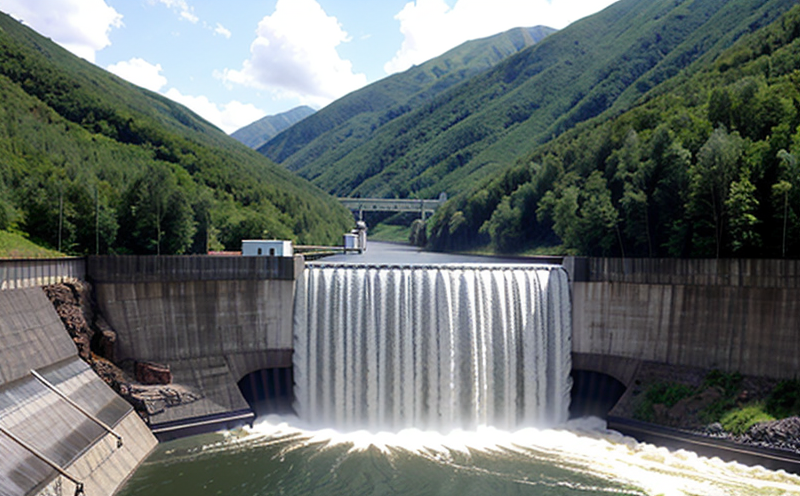ASTM E164 Ultrasonic Testing of Runner Welds
The ASTM E164 standard specifies a method for ultrasonic testing (UT) of runner welds in hydroelectric turbine runners. This non-destructive testing technique is essential for ensuring the structural integrity and operational reliability of critical components within hydropower systems. Runner welds are exposed to significant mechanical stress due to the high-velocity water flow through the turbine, making their quality control crucial.
UT involves directing a high-frequency sound wave into the material using a probe. The sound wave penetrates the part and reflects back when it encounters changes in density or structure, such as cracks or defects within the weld. By analyzing these reflections, technicians can identify potential flaws without altering the component's integrity. This method is particularly suited for hydropower applications because of its ability to detect minute flaws that could compromise safety.
The process begins with thorough preparation and calibration of the UT equipment. The probe is adjusted according to the geometry of the runner welds, ensuring accurate detection capabilities. Specimens are then exposed to ultrasonic waves, and the reflected signals are captured for analysis. Ultrasonic testing can identify various types of defects, including porosity, inclusions, cracks, and incomplete fusion, all critical issues that could lead to premature failure.
ASTM E164 provides detailed acceptance criteria based on flaw size and location. Defects exceeding specified limits are deemed unacceptable, necessitating repair or replacement. This standard ensures uniformity across the industry by establishing clear benchmarks for acceptable quality levels. Compliance with ASTM E164 not only enhances safety but also supports regulatory compliance requirements.
Understanding the context of hydropower systems is crucial when implementing ASTM E164 testing. Turbine runners are integral to converting water power into mechanical energy, driving generators that produce electricity. Any flaw in these components can lead to catastrophic failures, disrupting operations and risking personnel safety. Therefore, ensuring runner weld integrity through rigorous UT procedures aligns with broader sustainability goals by promoting reliable and safe hydropower generation.
In summary, ASTM E164 ultrasonic testing of runner welds is a vital process for maintaining the structural soundness of critical components in hydropower systems. By employing this non-destructive technique, quality managers can identify potential flaws early, preventing costly repairs and ensuring long-term reliability.
Why It Matters
Ensuring the structural integrity of hydroelectric turbine runners is paramount for safe and efficient hydropower generation. Runner welds are particularly susceptible to stress-induced defects due to their exposure to high-velocity water flows. These defects can lead to catastrophic failures, causing significant downtime, financial losses, and potential safety hazards.
Compliance with ASTM E164 standards is not only a legal requirement but also a best practice for maintaining operational excellence. By adhering to these guidelines, organizations demonstrate their commitment to quality assurance and regulatory compliance. This adherence translates into enhanced reputation, reduced risks, and increased stakeholder confidence.
The reliability of hydropower systems directly impacts the sustainability of renewable energy sources. Ensuring that turbine runner welds meet rigorous testing standards helps sustain reliable power generation, thereby supporting broader environmental goals. Sustainable practices in this sector are critical for reducing carbon footprints and promoting green initiatives.
Why Choose This Test
- Non-Destructive Evaluation: ASTM E164 UT allows for thorough inspection without altering the integrity of the runner welds, preserving valuable assets.
- Early Detection of Flaws: Identifying defects early through this testing method minimizes the risk of catastrophic failures and associated costs.
- Compliance with Standards: Meeting ASTM E164 ensures compliance with industry best practices and regulatory requirements, enhancing credibility.
- Safety Assurance: Ensuring structural integrity through rigorous testing promotes safe operations, protecting personnel and the environment.
- Risk Mitigation: Early detection of potential issues helps mitigate risks associated with equipment failure and operational disruptions.
- Economic Benefits: By avoiding costly repairs and downtime, this testing method contributes to substantial cost savings over time.
The combination of these benefits makes ASTM E164 ultrasonic testing an indispensable tool for maintaining the reliability and safety of hydropower systems.
Environmental and Sustainability Contributions
The implementation of ASTM E164 ultrasonic testing supports broader environmental sustainability goals by ensuring efficient and reliable hydropower generation. By detecting defects early, this process prevents catastrophic failures that could disrupt operations and lead to significant downtime. This reliability is crucial for maintaining consistent power supply, which in turn reduces the need for fossil fuel-based alternatives, contributing positively to carbon reduction efforts.
Moreover, by adhering to ASTM E164 standards, organizations can demonstrate their commitment to sustainable practices, thereby enhancing their reputation and attracting environmentally conscious stakeholders. This alignment with international sustainability initiatives fosters a culture of responsibility within the industry.
In conclusion, ASTME164 ultrasonic testing plays a vital role in promoting both operational excellence and environmental stewardship, making it an essential service for hydropower systems.





